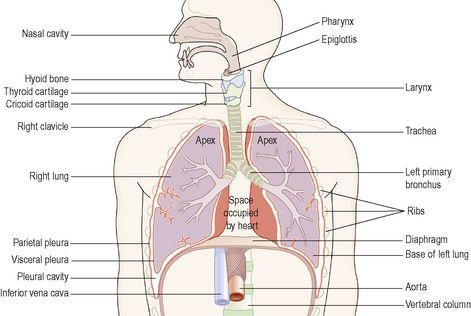Ross & Wilson Anatomy and Physiology in Health and Illness (107 page)
Read Ross & Wilson Anatomy and Physiology in Health and Illness Online
Authors: Anne Waugh,Allison Grant
Tags: #Medical, #Nursing, #General, #Anatomy

Position
240
Structure
240
Functions
241
Lungs
242
Position and gross structure
242
Pleura and pleural cavity
243
Interior of the lungs
244
Bronchi and bronchioles
244
Structure
244
Functions
245
Respiratory bronchioles and alveoli
245
Structure
245
Functions
246
Respiration
246
Breathing
247
Exchange of gases
250
Control of respiration
252
Disorders of the upper respiratory tract
254
Infectious and inflammatory disorders
254
Tumours
255
Obstructive lung disorders
255
Bronchitis
255
Emphysema
256
Asthma
256
Bronchiectasis
257
Cystic fibrosis (mucoviscidosis)
258
Restrictive disorders
258
Pneumoconioses
258
Chemically induced lung diseases
259
Lung infections
260
Pneumonia
260
Lung abscess
261
Tuberculosis (TB)
261
Lung tumours
262
Bronchial carcinoma
262
Pleural mesothelioma
262
Lung collapse
262
ANIMATIONS
10.1
Air distribution through the upper respiratory tract
234
10.2
Air distribution through the lower respiratory tract
234
10.3
Respiratory mucosa
235
10.4
Bronchi and bronchioles
244
10.5
Alveoli
245
10.6
Respiratory membrane
245
10.7
Role of the diaphragm in breathing
247
10.8
Pulmonary ventilation
248
10.9
External repiration
250
10.10
Internal respiration
251
10.11
Summary of external and internal respiration
251
This chapter describes the structure and functions of the respiratory system. Some common respiratory disorders are described in the illnesses section at the end of the chapter.
The cells of the body need energy for all their metabolic activities. Most of this energy is derived from chemical reactions, which can only take place in the presence of oxygen (O
2
). The main waste product of these reactions is carbon dioxide (CO
2
). The respiratory system provides the route by which the supply of oxygen present in the atmospheric air enters the body, and it provides the route of excretion for carbon dioxide.
The condition of the atmospheric air entering the body varies considerably according to the external environment, e.g. it may be dry, cold and contain dust particles or it may be moist and hot. As the air breathed in moves through the air passages to reach the lungs, it is warmed or cooled to body temperature, moistened to become saturated with water vapour and ‘cleaned’ as particles of dust stick to the mucus which coats the lining membrane. Blood provides the transport system for O
2
and CO
2
between the lungs and the cells of the body. Exchange of gases between the blood and the lungs is called
external respiration
and that between the blood and the cells
internal respiration
. The organs of the respiratory system are:
•
nose
•
pharynx
•
larynx
•
trachea
•
two bronchi (one bronchus to each lung)
•
bronchioles and smaller air passages
•
two lungs and their coverings, the pleura
•
muscles of breathing – the intercostal muscles and the diaphragm.
A general view of the organs of the respiratory system is given in
Figure 10.1.
Figure 10.1
Structures associated with the respiratory system.
Nose and nasal cavity
Learning outcomes
After studying this section, you should be able to:
describe the location of the nasal cavities
relate the structure of the nasal cavities to their function in respiration
outline the physiology of smell.
Position and structure
The nasal cavity is the main route of air entry, and consists of a large irregular cavity divided into two equal passages by a
septum
. The posterior bony part of the septum is formed by the perpendicular plate of the ethmoid bone and the vomer. Anteriorly, it consists of hyaline cartilage (
Fig. 10.2
).


